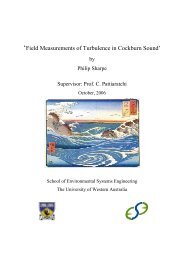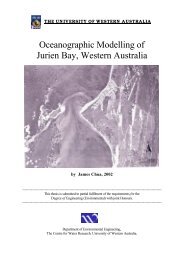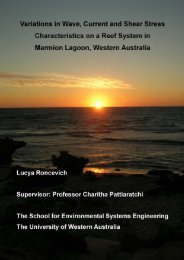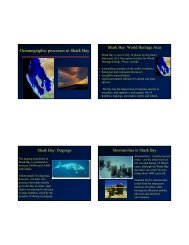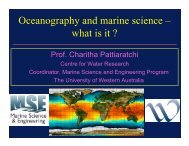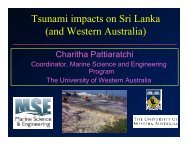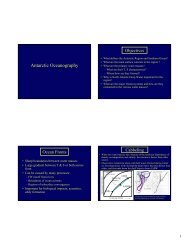Directional Waves in the Nearshore Coastal Region of Perth ...
Directional Waves in the Nearshore Coastal Region of Perth ...
Directional Waves in the Nearshore Coastal Region of Perth ...
You also want an ePaper? Increase the reach of your titles
YUMPU automatically turns print PDFs into web optimized ePapers that Google loves.
<strong>Directional</strong> waves <strong>in</strong> <strong>the</strong> nearshore coastal region <strong>of</strong> <strong>Perth</strong>, Western AustraliaHuey Jean TanABSTRACTThe conventional approach for wave analysis is <strong>the</strong> relatively simple monochromatic waveapproach, which is still widely used <strong>in</strong> coastal and <strong>of</strong>fshore applications. This traditionalmethod does not consider <strong>the</strong> direction <strong>of</strong> wave propagation, which is an important factor toconsider <strong>in</strong> order to realistically characterise <strong>the</strong> natural surface waves <strong>of</strong> <strong>the</strong> ocean.<strong>Directional</strong> wave methods are more complex, time consum<strong>in</strong>g and expensive than <strong>the</strong>conventional monochromatic wave approach. However, it has been proven that directionalwave analysis <strong>of</strong>fers a more accurate representation <strong>of</strong> natural ocean waves, and that <strong>the</strong>re aresignificant differences between <strong>the</strong> transformations <strong>of</strong> monochromatic and directional waves.<strong>Directional</strong> waves <strong>in</strong> <strong>the</strong> nearshore coastal region <strong>in</strong>fluence <strong>the</strong> direction <strong>of</strong> littoral drift on <strong>the</strong>beach, which, <strong>in</strong> turn, affects <strong>the</strong> morphology on <strong>the</strong> beach. The beaches along <strong>the</strong> coastl<strong>in</strong>e<strong>of</strong> <strong>Perth</strong>, Western Australia, exhibit seasonal variations <strong>in</strong> beach morphology. The ma<strong>in</strong> aim<strong>of</strong> <strong>the</strong> present study was to carry out an analysis <strong>of</strong> <strong>the</strong> directional waves <strong>in</strong> <strong>the</strong> nearshoreregion <strong>of</strong> <strong>the</strong> coastal waters <strong>of</strong> <strong>Perth</strong>. This was achieved by analys<strong>in</strong>g <strong>the</strong> directional wavedata collected at Cables Artificial Surf<strong>in</strong>g Reef (ASR) <strong>in</strong> August 1999 (i.e. w<strong>in</strong>ter) and at CityBeach dur<strong>in</strong>g January and February 2001 (i.e. summer). More specifically, due to <strong>the</strong> fact thatwave growth and <strong>the</strong> direction <strong>of</strong> wave propagation are directly affected by w<strong>in</strong>d, this study<strong>in</strong>vestigated <strong>the</strong> wave response to <strong>the</strong> chang<strong>in</strong>g w<strong>in</strong>d climate. The summer data (i.e. at CityBeach) <strong>in</strong>dicated that <strong>the</strong> propagation <strong>of</strong> nearshore waves were predom<strong>in</strong>antly <strong>in</strong> <strong>the</strong> nor<strong>the</strong>astdirection, whereas <strong>the</strong> w<strong>in</strong>ter data (i.e. at Cables ASR) displayed directional waves <strong>in</strong> apredom<strong>in</strong>ant east-sou<strong>the</strong>ast direction. This is <strong>in</strong> agreement with <strong>the</strong> observations by Massel<strong>in</strong>k& Pattiaratchi (2001) <strong>of</strong> <strong>the</strong> prevail<strong>in</strong>g northward sediment transport dur<strong>in</strong>g <strong>the</strong> summermonths and southward longshore transport dur<strong>in</strong>g <strong>the</strong> w<strong>in</strong>ter months. Swell waves dur<strong>in</strong>gsummer is predom<strong>in</strong>antly <strong>in</strong> <strong>the</strong> east-nor<strong>the</strong>ast direction, whereas <strong>the</strong> dom<strong>in</strong>ant swell direction<strong>in</strong> w<strong>in</strong>ter is east-sou<strong>the</strong>ast. The daily sea breeze events dur<strong>in</strong>g summer generate sea waves <strong>in</strong><strong>the</strong> nor<strong>the</strong>asterly direction. Sea waves generated by storm events change from sou<strong>the</strong>asterly tonor<strong>the</strong>asterly with <strong>the</strong> passage <strong>of</strong> mid-latitude depressions, however <strong>the</strong> direction <strong>of</strong> swellwaves rema<strong>in</strong> constant <strong>in</strong> <strong>the</strong> east-sou<strong>the</strong>asterly direction. Dur<strong>in</strong>g <strong>the</strong> summer sampl<strong>in</strong>gperiod, <strong>the</strong> mean significant wave height (H s ) was 0.77 m, and <strong>the</strong> maximum H s achieveddur<strong>in</strong>g a sea breeze event was 1.33 m. For <strong>the</strong> w<strong>in</strong>ter sampl<strong>in</strong>g period, <strong>the</strong> mean H s was 1.17Abstracti



